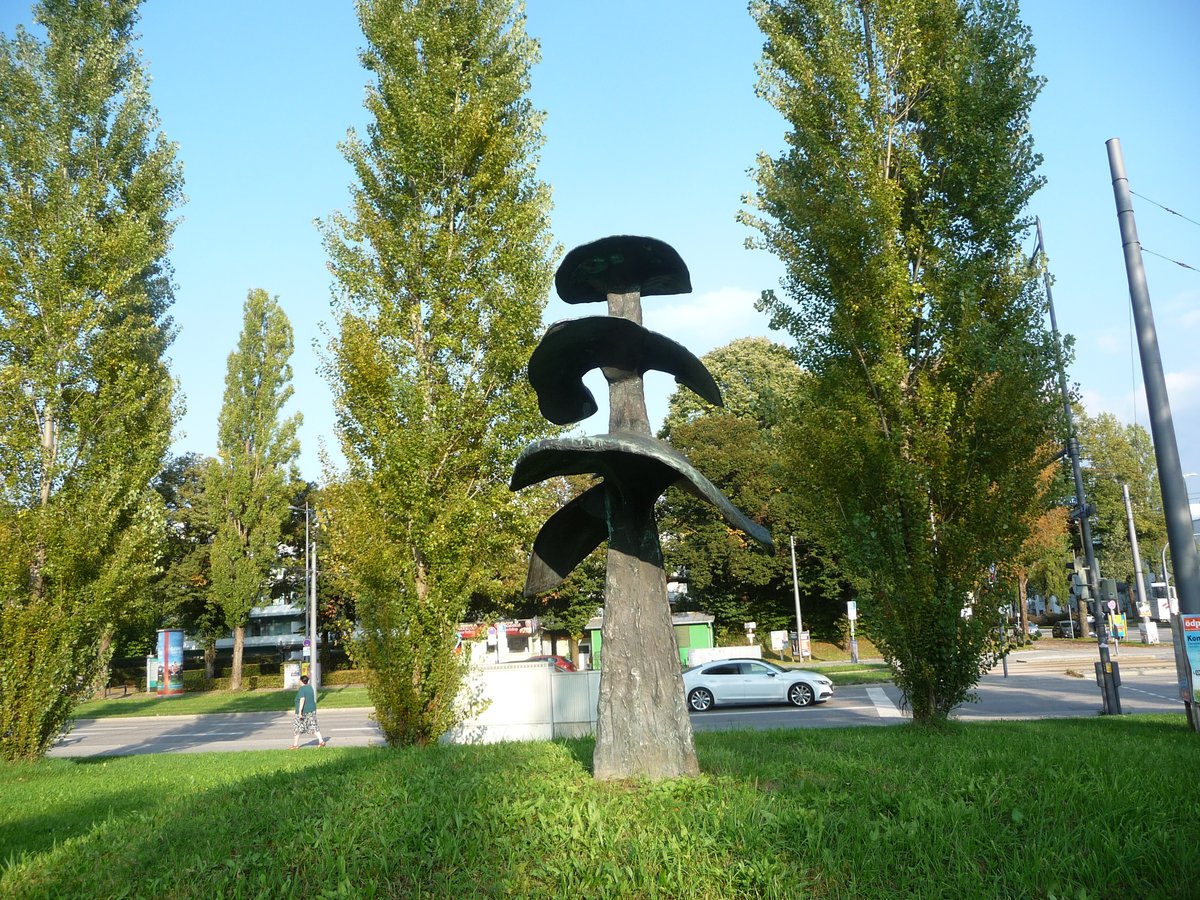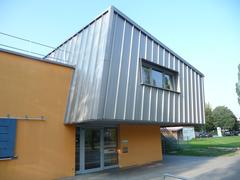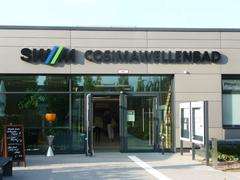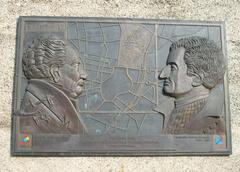
Bogenhausen Munich Visiting Guide: History, Tickets, Hours, and Tips
Date: 14/06/2025
Introduction: Discovering Bogenhausen’s Allure
Bogenhausen, Munich’s 13th and largest borough, is a captivating district that harmoniously combines historical legacy, architectural splendor, and tranquil green spaces. Once a rural village on the Isar’s eastern bank, Bogenhausen evolved into an affluent, culturally prominent neighborhood, reflecting Munich’s dynamic urban development. Today, it invites visitors to explore art-nouveau villas, renowned museums, grand theaters, and leafy riverbanks. Bogenhausen is also significant in Munich’s Jewish history, with memorials and heritage sites honoring the community’s legacy.
This in-depth guide presents Bogenhausen’s history, major attractions, practical information (including opening hours and ticket details), and travel tips. Whether you’re an art lover, a history enthusiast, or a traveler seeking peaceful parks and Bavarian cuisine, Bogenhausen offers an enriching and memorable Munich experience.
For up-to-date itineraries, cultural events, and visitor resources, explore Munich Tourism, Villa Stuck, and Prinzregententheater.
Contents
- Introduction
- History and Evolution
- Architectural Highlights & Landmarks
- Jewish Heritage
- Parks, Green Spaces, and Recreation
- Festivals and Events
- Practical Visitor Tips
- Accessibility
- Accommodation & Dining
- Getting There & Around
- Frequently Asked Questions (FAQs)
- Conclusion
- References
History and Evolution of Bogenhausen
From Rural Roots to Urban Prestige
Bogenhausen’s origins trace back to a humble riverside village, first recorded in the Middle Ages. For centuries, it remained a rural settlement dominated by agriculture (Wikipedia: Bogenhausen). Its transformation began in 1805 with the Treaty of Bogenhausen, marking the area’s growing political importance. The real turning point came in 1892, when Bogenhausen was incorporated into Munich, prompting rapid urban development to accommodate the city’s expanding population (Munich Travel: Walk Bogenhausen).
The Villa District and Modern Expansion
After incorporation, Bogenhausen became a magnet for Munich’s elite. Grand villas and stately homes emerged in Alt-Bogenhausen, attracting industrialists, artists, and diplomats. The area’s architectural character flourished with Art Nouveau and Historicist styles, many of which are preserved today (Foravisit: Bogenhausen). The 20th century saw the development of new residential areas like Herzogpark and Parkstadt, blending classic and modern architecture.
Architectural Highlights & Landmarks
Alt-Bogenhausen: Art Nouveau and Historicism
Alt-Bogenhausen, the district’s historic core, is renowned for its elegant Art Nouveau (Jugendstil) villas, built between 1890 and 1914. Streets like Ismaninger Straße and Maria-Theresia-Straße are lined with ornate facades, intricate ironwork, and lush gardens (Munich Travel: Walk Bogenhausen). Walking here reveals Munich’s architectural evolution and the opulent lifestyle of its early residents.
Villa Stuck
A masterpiece of Jugendstil, Villa Stuck was built in 1898 as the home and studio of artist Franz von Stuck. Today, it serves as a museum showcasing Stuck’s work and contemporary exhibitions—its interiors are a Gesamtkunstwerk of art and design.
- Opening Hours: Tues–Sun, 10:00–18:00; closed Mondays
- Tickets: Adults €10, reduced/concession rates available; under 18 free
- Guided Tours: Weekends at 11:00 and 15:00, advance booking recommended
(Villa Stuck Official Website)
Prinzregententheater
The Prinzregententheater, opened in 1901, is an architectural gem inspired by classical amphitheaters. It remains a major venue for opera, ballet, and classical music.
- Box Office: Tues–Sat, 10:00–18:00
- Tickets: Vary by event; book in advance via official website
- Special Events: Regular opera, ballet, and concerts
Friedensengel (Angel of Peace)
Standing at the western entrance of Bogenhausen, the Friedensengel monument features a gilded statue of Nike atop a 38-meter column, commemorating 25 years of peace after the Franco-Prussian War.
- Hours: Open daily, dawn to dusk; free entry
Modernist Landmarks
The Hypo-Hochhaus skyscraper, Parkstadt Bogenhausen’s postwar residential buildings, and the striking “Mae West” sculpture at Effnerplatz add contemporary character (life-globe.com). These sites are accessible from public streets and squares.
Jewish Heritage
Community Roots and Remembrance
Bogenhausen welcomed many prominent Jewish families in the late 19th and early 20th centuries, enriching its intellectual and cultural life (New York Jewish Travel Guide). During the Nazi era, residents suffered persecution and deportation; today, memorial plaques and Stolpersteine (“stumbling stones”) commemorate victims throughout the district (Munich Travel: Judaism in Munich).
Jewish Cemetery at Nordfriedhof
The Jewish section of Nordfriedhof is an important site for remembrance, featuring gravestones with Hebrew inscriptions and Holocaust memorials.
- Hours: Open daily, 8:00 to dusk; free entry
Proximity to Jewish Cultural Sites
While Bogenhausen itself does not contain major synagogues or Jewish museums, its proximity to St. Jakobs Platz makes it easy to reach the Ohel Jakob Synagogue and Jewish Museum Munich by tram or U-Bahn (Secret Attractions).
Parks, Green Spaces, and Recreation
Maximiliansanlagen and the Isar River
The scenic Maximiliansanlagen Park borders the Isar River and is open year-round for jogging, cycling, and picnics. The riverbanks are especially popular at sunset for their views.
Proximity to Englischer Garten
The world-famous Englischer Garten is a short walk or bike ride away, providing extensive green space and iconic sites like the Chinese Tower beer garden (munich-business-school.de).
Other Nearby Parks
- Old Botanical Garden: Free entry, daily
- Olympic Park: Year-round access; Olympic Tower open 10:00–20:00 (€9 adults)
Festivals and Annual Events
Munich Film Festival
Held late June to early July, this prestigious event screens films citywide, including venues easily reached from Bogenhausen (munich.travel).
Munich Opera Festival
Running throughout July, the Opera Festival features performances at major theaters including the Prinzregententheater (kingshotels.de).
Summer Festivals and Concerts
Summer brings open-air music events such as Tollwood and Theatron-Pfingstfestival. Major concerts and sports take place at nearby Allianz Arena and Olympic Park.
Practical Visitor Tips
Getting There and Around
Bogenhausen is well-served by public transport:
- U-Bahn: U4 (Arabellapark, Richard-Strauss-Straße), U5 (Max-Weber-Platz)
- S-Bahn: S8 (Leuchtenbergring, direct to Airport)
- Trams/Buses: Frequent service via Effnerplatz and major intersections
(MVV Munich Transport)
Munich Card & City Pass grants unlimited travel and attraction discounts (Munich Card & City Pass).
Accommodation
Bogenhausen offers a range of hotels from luxury (e.g., München Palace, Westin Grand Munich) to boutique guesthouses and serviced apartments, especially around Arabellapark and Alt-Bogenhausen (life-globe.com). Book in advance during festivals.
Dining & Shopping
From Michelin-recommended restaurants like Käfer-Schänke to cozy cafés and Bavarian beer gardens, Bogenhausen’s culinary scene suits every taste. The district also features boutique shops and a weekly farmers’ market at Cosimapark (Kathrin Di Lauro: Insider’s Guide).
Accessibility
Most public areas, parks, and major venues are wheelchair accessible. U-Bahn and S-Bahn stations have elevators and ramps. For specific needs, contact venues or the Munich Tourist Office.
Safety and Local Etiquette
Bogenhausen is among Munich’s safest neighborhoods. Respect quiet residential areas, especially in the evening. Standard urban precautions apply.
Weather and Packing
Expect warm summers (average 24°C/75°F) and cold winters. Bring layers and comfortable shoes (Best Time to Visit Munich).
Connectivity
Free Wi-Fi is widely available in hotels, cafés, and public spaces. For longer stays, consider a local SIM card.
Frequently Asked Questions (FAQs)
Q: What are the visiting hours for Villa Stuck?
A: Tuesday–Sunday, 10:00–18:00; closed Mondays (Villa Stuck Official Website).
Q: Is the Friedensengel monument free to visit?
A: Yes, it’s open daily and free of charge.
Q: How do I get tickets for Prinzregententheater events?
A: Via the official website or at the box office.
Q: Are guided tours available in Bogenhausen?
A: Yes, especially for Villa Stuck, the Friedensengel, and architectural highlights—book in advance.
Q: Is Bogenhausen suitable for families and accessible for visitors with mobility challenges?
A: Absolutely; most parks and venues are family-friendly and accessible, but check with specific sites in advance.
Conclusion
Bogenhausen is a distinguished Munich borough that seamlessly blends historic charm, architectural elegance, and vibrant culture. From Art Nouveau villas and iconic monuments to tranquil parks and a thriving culinary scene, it offers something for every traveler. Its strong ties to Munich’s Jewish heritage and its calendar of festivals and events further enrich the visitor experience. With excellent transport links, diverse accommodation, and a welcoming atmosphere, Bogenhausen is an essential destination for anyone exploring Munich.
For updates on events, opening hours, and travel tips, use the Audiala app, consult official tourism portals, and follow local guides. Begin your journey to Bogenhausen and immerse yourself in the unique character of Munich’s historic heart.
References
- Bogenhausen, 2025, Wikipedia
- Exploring Bogenhausen, 2024, Munich Travel
- Foravisit: Bogenhausen, 2024
- Villa Stuck Official, 2024
- Prinzregententheater, 2024, Foravisit
- Friedensengel, 2024, Munich Travel
- Kathrin Di Lauro, 2021, Insider’s Guide
- Jewish Heritage in Munich, 2024, Munich Travel
- Secret Attractions, 2024
- Munich Card & City Pass, 2024, Official Tourism
- MVV Munich Transport, 2024
- Villa Stuck Official Website, 2024
- Prinzregententheater Official, 2024







































































































